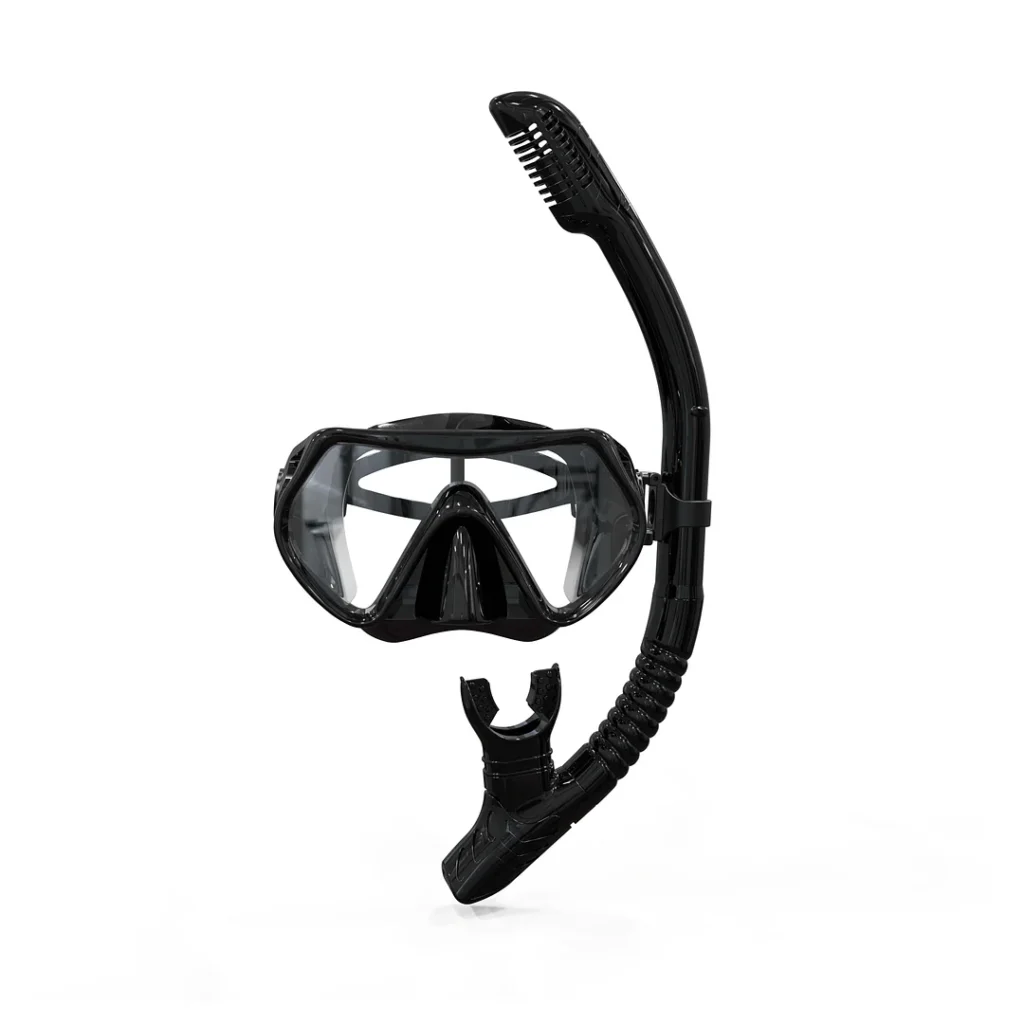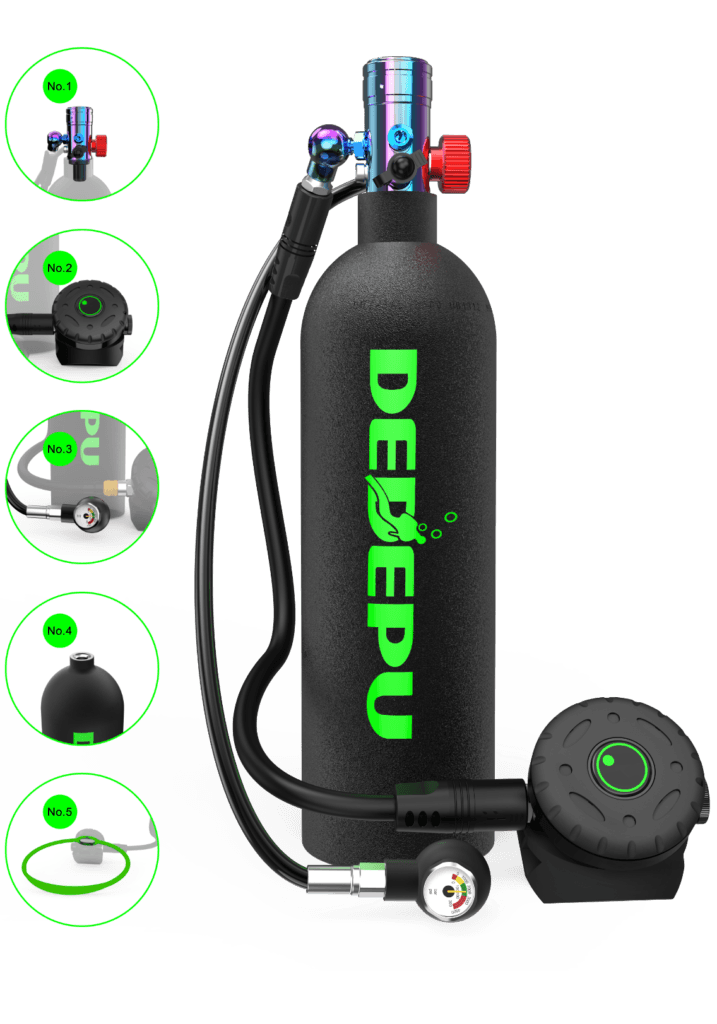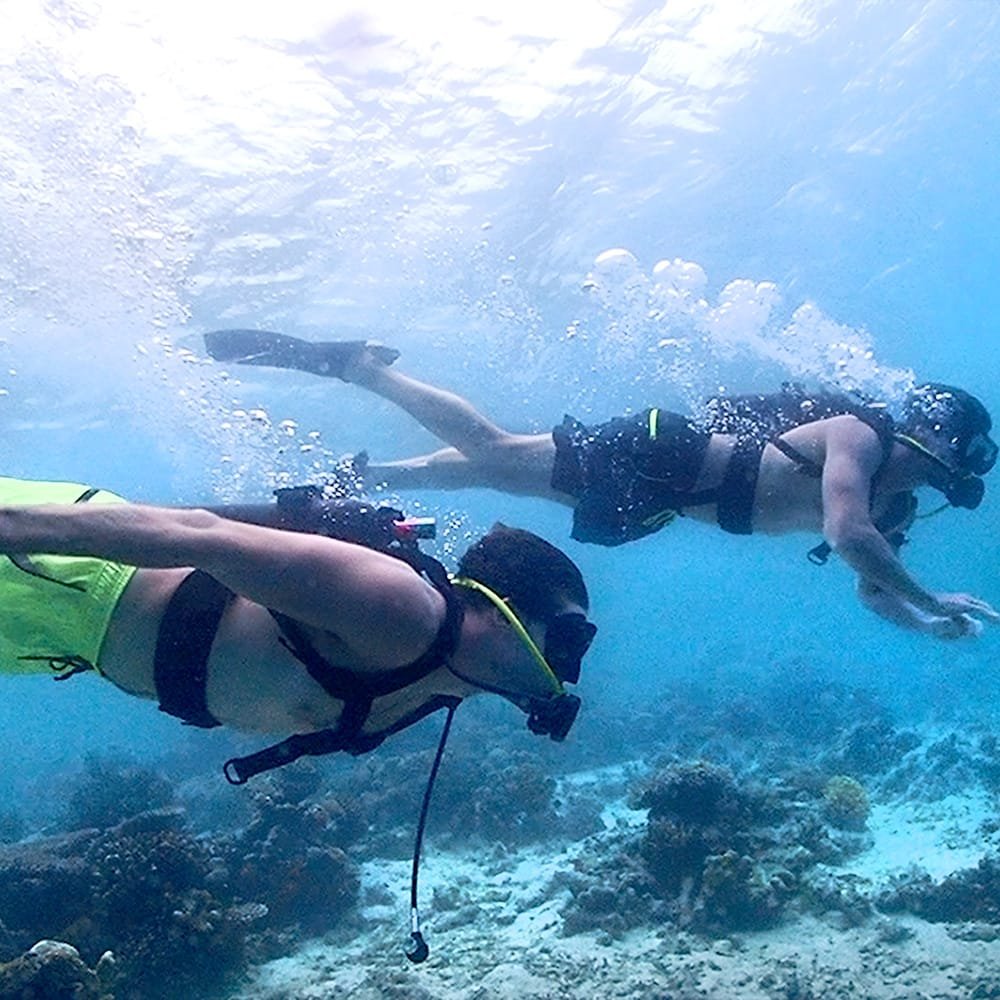Top 10 Must-Have Scuba Diving Equipment for Beginners
Getting into scuba diving is an exciting way to explore the underwater world, but it’s essential to have the right equipment for a safe and enjoyable experience. As a beginner, the variety of scuba diving gear can be overwhelming, so we’ve compiled a list of the top 10 must-have scuba diving equipment to help you get started. Each piece of gear plays a critical role in making your dives comfortable, safe, and efficient.
Let’s dive in and explore the purpose of each gear essential item for your scuba diver adventure.
Essential scuba diving gear table:
| Equipment | Purpose | Key Features to Consider |
| 1. Dive Mask | Allows clear vision underwater by creating an air pocket in front of your eyes. | Fit & Comfort, Field of Vision, Skirt Material, Low Volume |
| 2. Snorkel | Conserves air supply by allowing you to breathe at the surface without using your tank. | Dry-Top Snorkels, Comfort & Flexibility, Purge Valve |
| 3. Diving Fins | Provide efficient propulsion through the water, reducing energy consumption. | Open-Heel vs. Full-Foot, Blade Design |
| 4. Wetsuit | Regulates body temperature by providing insulation, even in warm water. | Thickness, Fit |
| 5. Buoyancy Control Device (BCD) | Controls buoyancy, allowing you to ascend, descend, or hover at a specific depth. | Air Control, Integrated Weight Systems |
| 6. Regulator | Reduces tank pressure to a breathable level and delivers air through a mouthpiece. | Octopus (Backup Regulator), Comfort |
| 7. Dive Computer | Tracks depth, bottom time, and no-decompression limits to ensure safe diving. | Clear Display, Essential Data |
| 8. Weight System | Offsets buoyancy from wetsuit and equipment, helping maintain neutral buoyancy under the sea. | Proper Weighting, Weight Distribution |
| 9. Underwater Camera | Captures photos and videos of your underwater experiences. | Action Cameras vs. Advanced Cameras, Durability, Photo Quality |
| 10. Scuba Tank (Air Cylinder) | Provides the air supply you breathe underwater, typically containing regular air (21% oxygen). | Tank Size, Material (Aluminum vs. Steel), Breathable Time |
Dive Mask for scuba dive
Keywords: scuba diving equipment, dive mask, diving gear

A scuba mask is your gateway to the mesmerizing underwater world, allowing you to witness its beauty with clarity and precision. Whether you’re a first-time diver or an experienced one looking to upgrade your scuba diving equipment, selecting the right dive mask is essential for an enjoyable and immersive experience.
Why You Need a Dive Mask
Underwater, light behaves differently because water and air have distinct refractive indexes. Without a dive mask, the under the sea , world would appear blurry and distorted. A dive mask creates a much-needed air pocket in front of your eyes, enabling you to see with clarity and navigate with ease.
Key Features to Consider in a Scuba Mask
- Fit and Comfort: Comfort is crucial, especially when spending extended time beneath the surface. A dive mask that fits snugly without being too tight ensures no water leaks in while maintaining comfort. Test the fit by gently pressing the mask onto your face (without the strap) and inhaling slightly through your nose. If it stays in place without slipping, you’ve likely found a well-fitting mask. Remember, the mask should feel secure without applying excessive pressure.
- Field of Vision: When exploring the underwater world, having a wide field of vision enhances your experience. Look for masks with a broad lens that offers excellent peripheral vision, allowing you to fully immerse yourself in the environment, whether you’re swimming alongside colorful fish or admiring coral reefs. A mask that maximizes visibility can be the difference between a good and an unforgettable dive.
- Skirt Material: The mask’s skirt—the part that creates a seal on your face—should be made of high-quality silicone. Silicone provides a flexible, comfortable seal that molds to your face over time, ensuring both durability and comfort. Clear silicone skirts can allow more light in, while black silicone helps reduce glare, depending on your preference.
- Low Volume: For experienced divers, a low-volume mask is often preferred as it requires less effort to equalize the air space within the mask when diving deeper. This feature is particularly useful for those advancing their skills or aiming for deep dives.
Enhancing Your Scuba Diving Experience
A well-chosen dive mask is more than just a piece of diving gear—it enhances your overall scuba experience. Imagine the thrill of descending into a coral garden or swimming with a school of fish, seeing everything in sharp, vibrant detail. The right mask will give you confidence underwater, ensuring you’re free to explore and enjoy the dive rather than constantly adjusting your gear.
As you consider upgrading your scuba diving equipment, take the time to select a mask that fits your needs—whether it’s superior comfort, a wide field of vision, or advanced features for deeper dives. After all, a great dive starts with great gear.
Snorkel for scuba dive
Keywords: diving snorkel, scuba gear
While a snorkel is often associated with casual snorkeling, it’s just as important for scuba divers. On the surface, a snorkel allows you to breathe freely without depleting the air in your tank. This means you can save your tank air for the actual dive, maximizing your time underwater. Whether you’re relaxing at the surface, waiting for the rest of your group, or heading back to the dive boat, having a snorkel makes the experience more enjoyable and stress-free.
Choosing the Right Snorkel
Dry-Top Snorkels: If you’re a beginner or looking for a snorkel that provides extra ease and safety, consider a dry-top snorkel. This design features a valve at the top that closes when the snorkel is submerged, preventing water from entering the tube. This is particularly useful for novice divers who may be worried about accidentally inhaling water. With a dry-top snorkel, you can focus more on the experience and less on clearing water from the tube.
Comfort and Flexibility: A comfortable snorkel is essential for long dives. Look for a model with a soft silicone mouthpiece that fits easily in your mouth without causing jaw fatigue. Additionally, a flexible snorkel tube can reduce strain and provide a more comfortable fit when worn alongside your dive mask.
Purge Valve: Many snorkels come with a purge valve, a handy feature that allows you to easily expel any water that may enter the snorkel. By simply exhaling, water is forced out through the valve, keeping your airway clear without needing to remove the snorkel from your mouth.
Diving Fins
Keywords: scuba diving fins, dive fins, diving gear
Dive fins provide the propulsion you need to move efficiently through the water. Unlike swimming, where your legs and feet generate movement, dive fins allow you to cover more distance with less effort, conserving your energy and air.
Types of fins:
There are two main types—open-heel and full-foot. Open-heel fins are worn with booties (neoprene socks), offering more protection and comfort in cold or rocky conditions, while full-foot fins fit like shoes and are best for warm water diving.
Blade design:
The stiffness and size of the fin blade affect how much power you generate with each kick. Beginners often start with a moderately flexible blade, which offers a balance between power and ease of use.
Right Wetsuit
Keywords: diving wetsuit, scuba diving wetsuit
A wetsuit is crucial for regulating your body temperature while diving. Even in warm water, your body loses heat quickly, and a wetsuit helps you stay comfortable by trapping a thin layer of water between your skin and the suit. Your body heats this water, creating insulation that keeps you warm.
Thickness:
Wetsuits come in varying thicknesses, typically ranging from 3mm to 7mm. Thicker suits provide more insulation for cold water, while thinner suits are ideal for warm tropical dives.
Fit:
A wetsuit should fit snugly but not be restrictive. If it’s too loose, water will flow freely through the suit, making it less effective at keeping you warm.
Buoyancy Control Device (BCD)
Keywords: scuba diving BCD, buoyancy control device
The Buoyancy Control Device (BCD) is essential for managing your buoyancy during a dive. It allows you to add or release air from an inflatable bladder to adjust your buoyancy, letting you hover effortlessly at any depth without sinking or floating to the surface.
How it works: You can add air to the BCD to make yourself more buoyant or release air to become neutrally buoyant. This is especially important for controlling your position underwater and minimizing effort.
Integrated weight systems: Many BCDs have integrated pockets for weights, which help you descend and stay submerged. This eliminates the need for a separate weight belt.
Regulator
Keywords: scuba diving regulator, diving regulator
A regulator is the piece of equipment that allows you to breathe underwater. It reduces the high-pressure air from your tank to a breathable level and delivers it through a mouthpiece. Regulators typically consist of two stages: the first stage connects to your tank and reduces the pressure of the air, while the second stage delivers the air to you as you inhale.
Octopus:
In addition to your primary regulator, most setups include an octopus, which is a backup regulator used in emergencies or to share air with a dive buddy.
Comfort:
Look for a regulator with a comfortable mouthpiece that fits well, as you’ll be using it throughout your dive.
Dive Computer
Keywords: scuba dive computer, dive computer
A dive computer is one of the most important tools for tracking your depth, bottom time, and no-decompression limits during a dive. It calculates how long you can safely stay underwater based on your dive profile, helping to prevent decompression sickness. Dive computers replace traditional dive tables and gauges by providing real-time, accurate information.
Key features:
For beginners, it’s important to choose a dive computer that’s easy to read, with clear display screens that show essential data like depth, remaining no-decompression time, and ascent rate.
Weight System
A weight system is an essential component of your scuba diving gear, designed to counteract the natural buoyancy of your wetsuit and equipment. By adding the right amount of scuba diving weights, you can achieve neutral buoyancy, allowing you to descend smoothly and maintain control underwater. Whether worn on a belt or integrated into your BCD (Buoyancy Control Device), the proper weight system ensures a more comfortable and efficient dive.
Why You Need a Weight System
When you’re underwater, your wetsuit and gear naturally create buoyancy, making it difficult to descend and stay at your desired depth. A weight system helps offset this buoyancy, allowing you to sink easily and maintain neutral buoyancy once you’re submerged. This balance is key for a smooth, enjoyable dive, as it prevents you from floating uncontrollably or using excessive energy to stay down.
Proper Weighting for Diving
- Finding the Right Balance: Achieving the right balance with your weights is critical. If you use too much weight, it can be difficult to ascend when necessary, increasing your risk of rapid descents or struggling to rise to the surface safely. On the other hand, too little weight can make it hard to descend or keep you floating uncontrollably, disrupting your dive and making it hard to stay underwater.
- Consider Your Wetsuit: The thickness of your wetsuit has a significant impact on how much weight you need. Thicker wetsuits provide more buoyancy, requiring additional weights to compensate. Divers using thinner wetsuits or diving in warmer waters may need fewer weights. Always adjust your weight system based on the conditions of your dive and your personal buoyancy needs.
- Weight Distribution: Weights can be distributed in different ways depending on your preference. Many divers choose a traditional weight belt, while others opt for integrated weight systems built into the BCD. Integrated weights offer the advantage of a streamlined setup, evenly distributing the weight for better comfort and control, while weight belts offer flexibility and can be easily adjusted during the dive.
Enhancing Your Dive Experience with Proper Weighting
Using a weight system that’s tailored to your dive gear and environment will make your underwater experience smoother and more enjoyable. Proper weighting not only helps you achieve neutral buoyancy but also conserves energy, allowing you to focus on the beauty of the underwater world.
When upgrading your scuba diving equipment, take the time to fine-tune your weight system to ensure it’s perfectly balanced. This small adjustment can make a big difference, keeping you safe, comfortable, and in control during your dives.
Underwater Camera
An underwater camera is an exciting addition to your diving gear, offering a unique way to capture the beauty of your dive experiences. While not a safety essential, it can greatly enhance your underwater adventures, allowing you to document marine life, coral reefs, and the stunning underwater landscapes you encounter. Whether you’re a recreational diver or an aspiring underwater photographer, having the right camera can make your dives even more memorable.
Why Use an Underwater Camera?
Diving is full of breathtaking moments, from encountering vibrant schools of fish to exploring mysterious shipwrecks. An underwater camera allows you to capture these scenes, bringing the underwater world to life even after you’ve surfaced. With the right equipment, you can take stunning photos and videos, creating lasting memories and sharing your experiences with others.
Types of Underwater Cameras
- Action Cameras: Action cameras, such as the GoPro, are popular among divers for their compact size, ease of use, and durability. These cameras are designed to withstand tough underwater conditions, making them a reliable choice for those looking for a simple, hands-free way to capture footage. Action cameras are perfect for recreational divers who want to record their dives without the need for complex equipment. They’re also versatile, allowing you to shoot both videos and photos during your dive.
- Advanced Underwater Cameras: For those interested in underwater photography and seeking higher image quality, advanced underwater cameras offer greater control over your shots. These cameras are equipped with larger sensors, allowing you to capture vibrant colors and sharp details even in deeper waters. Many advanced models come with interchangeable lenses and offer manual controls, giving you more flexibility in how you compose your shots. While they require a bit more setup and expertise, the results can be incredibly rewarding for divers serious about photography.
Enhancing Your Dive Experience with Photography
Having an underwater camera adds a creative dimension to your diving experience. It allows you to capture the incredible sights you encounter, whether it’s a curious sea turtle or a majestic coral formation. You’ll also be able to document your progression as a diver, recording everything from your first dive to your most challenging underwater exploration.
Whether you’re using a compact action camera or a more advanced system, adding an underwater camera to your diving gear ensures that the memories of your dives are as vivid as the day you experienced them. As you consider upgrading your gear, think about what kind of underwater photography appeals to you—whether it’s quick, action-packed footage or more refined, professional-quality photos.
Scuba Tank (Air Cylinder)
Keywords: scuba diving oxygen tank, air cylinder, scuba tank
The scuba tank or air cylinder provides the compressed air you breathe underwater. Contrary to the term “oxygen tank,” most scuba tanks contain a mixture of regular air (about 21% oxygen and 79% nitrogen). Understanding how to manage your air supply is key to diving safely.

Breathable Time
The length of time a tank lasts depends on:
Tank size:
A standard tank holds around 80 cubic feet of air.
Depth:
The deeper you go, the faster you use air. At 33 feet (2 atmospheres), air consumption doubles. At 66 feet, it triples.
Breathing rate: A calm, relaxed diver consumes less air. Beginners tend to use more air due to excitement or nervousness.
For example, at 33 feet, a diver might stay underwater for about 60 minutes with an 80 cubic foot tank. However, it’s important to always leave enough air in the tank (usually around 500 PSI) for safe ascents and emergencies.
Materials:
Tanks are usually made from aluminum or steel. Aluminum is lighter but steel holds more air.
Regular maintenance is critical for tanks. Visual inspections are required annually, and hydrostatic testing is done every five years to ensure the tank can handle the pressure.
Conclusion:
Scuba diving is a rewarding activity, but having the right equipment is crucial for both safety and enjoyment. As a beginner, investing in reliable, comfortable gear such as a dive mask, wetsuit, BCD, and dive computer will help you stay safe and get the most out of your underwater adventures. Each piece of equipment has a specific function that plays an important role in keeping you safe and allowing you to fully enjoy the underwater world.


thank you for making this article very useful and keep up the good work
Thanks for your comment, really appreciate, Blessings for you and love ones.
nice information and good article thank you